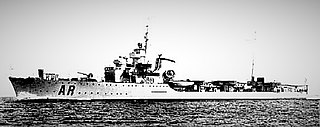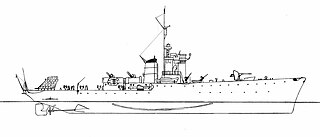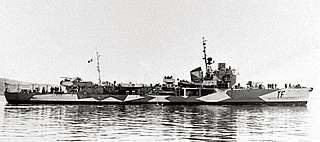Related Research Articles

The Soldati class were a group of destroyers built for the Regia Marina during World War II. The ships were named after military professions. There were two batches; twelve ships were built in 1938–1939, and a second batch of seven ships were ordered in 1940, although only five were completed.
The Ariete-class torpedo boats were a group of destroyer escorts built for the Italian Navy during World War II. They were enlarged versions of the Spica-class torpedo boats and designed to escort convoys to North Africa. Of the 42 units planned, sixteen ships were eventually ordered but only one was completed by the time of the armistice, Ariete, built in the Sestri Ponente shipyards and commissioned on 5 August 1943. The namesake ship was also the only one to survive the war. After the war it was ceded to the Yugoslav Navy (1949), and renamed Durmitor.

The Mirabello class were a group of three destroyers built for the Regia Marina during World War I. Carlo Alberto Racchia was sunk by a mine in the Black Sea during the Allied intervention in the Russian Civil War in 1920. The remaining two ships, obsolescent by 1938, were re-rated as destroyers and participated in World War II. Carlo Mirabello was also lost to a mine while escorting a convoy in 1941. The last surviving ship, Augusto Riboty, was reconfigured as a convoy escort in 1942–1943. The torpedo tubes were removed and depth charges and 20 mm (0.79 in) anti-aircraft guns added. She survived the war and was transferred to the Soviet Union as war reparations in 1946. The ship was scrapped five years later.

The Archimede class were a group of four submarines built for the Regia Marina in the early 1930s. The boats fought in the Spanish Civil War and in World War II. Under Spanish colors, these boats were known as the General Mola class, and remained in service until 1959.
The Foca class were a group of three minelaying submarines built for the Regia Marina during the 1930s. All three sister ships played minor roles during the Second World War. One was lost to unknown causes while trying to lay a minefield off British Palestine in 1940, but the other two survived the war to be discarded in 1947.

The Gabbiano-class corvettes were a group of 59 vessels built for the Regia Marina of Italy for service during the Second World War. They were built to a war-time design and intended for anti-submarine and escort duties.
Pietro Micca was an Italian submarine which served with the Regia Marina in World War II. She was the third ship named after Pietro Micca, the Savoyard soldier who became a national hero for his sacrifice in the defence of Turin against the French troops in 1706. This boat was the prototype for a class of fast, long range submarines with conventional torpedo armament, naval mine laying capability, and useful secret transport capacity. The ship was built at the Tosi shipyard in Taranto. She was laid down on 15 October 1931 and launched on 31 March 1935. The boat fully met design requirements, but was too expensive to be repeated.
The Pegaso class was a class of 18 Italian sea-going steam-powered torpedo boats built between 1904 and 1909. They served in the Italo-Turkish War and the First World War, when one was sunk, and continued in use until the 1920s.

The Soldato class was a class of destroyers of the Italian Regia Marina built by Ansaldo of Genoa prior to the First World War. Ten were built for the Regia Marina between 1905 and 1910, while an eleventh ship was built for China but purchased by Italy before completion. They served during the First World War, where one was lost, with the remaining ships sold for scrap in the 1920s and early 1930s.

The Nembo class was a class of destroyer of the Italian Regia Marina. Six destroyers were built by the Pattison shipyard of Naples between 1899 and 1905, to a design based on the contemporary destroyers of the British shipyard Thornycroft. They were active in the Italo-Turkish War and in the First World War, where three were lost.
The Sirio class was a class of six sea-going steam-powered torpedo boats of the Italian Regia Marina built by the German shipyard Schichau-Werke from 1904–1906. They served in the Italo-Turkish War and the First World War.
The Orione class was a class of four sea-going steam-powered torpedo boats of the Italian Regia Marina built by the Odero shipyard of Sestri Ponente from 1905 to 1907. They served in the Italo-Turkish War and the First World War.
The Rosolino Pilo class was a class of eight destroyers of the Italian Regia Marina constructed before and during the First World War. Like other obsolete Italian destroyers, they were reclassified as torpedo boats in 1929, and seven ships served throughout the Second World War. Two ships were sunk by mines while under Italian service during the Second World War, with two more being seized by Nazi Germany following the Italian Armistice in 1943. The remaining three ships survived the war and continued in use with the post-war Italian Navy, with the last two of the class being decommissioned in 1958.

Uragano was a Ciclone-class torpedo boat that served with the Italian Navy during the Second World War. The vessel entered service in 1942 and was sunk by a naval mine on 3 February 1943.

Tifone was a Ciclone-class torpedo boat that served with the Italian Navy during the Second World War. The vessel entered service on 11 July 1942 and was scuttled on 7 May 1943 at Korbous, Tunisia. She escorted the last Axis convoy to reach Africa in World War II.
Stromboli has been borne by at least four ships of the Italian Navy:
Augusto Riboty was one of three Mirabello-class destroyers built for the Regia Marina during World War I.
Carlo Mirabello was one of three Mirabello-class destroyers built for the Regia Marina during World War I.
The Settembrini class was a pair of submarines built for the Regia Marina during the late 1920s. They played a minor role in the Spanish Civil War of 1936–1939 supporting the Spanish Nationalists.
References
- ↑ Fraccaroli, Aldo (1970), Italian Warships of World War I, London: Ian Allan, p. 196, ISBN 0-7110-0105-7
- ↑ Fraccaroli, Aldo (1974) [1968], Italian Warships of World War II, London: Ian Allan, p. 95, ISBN 0-7110-0002-6